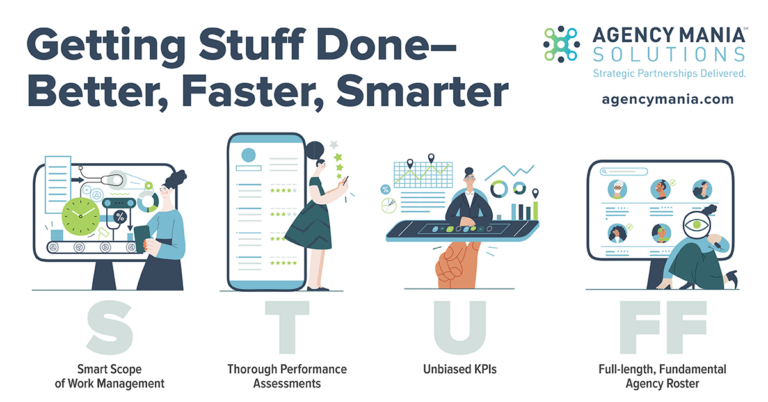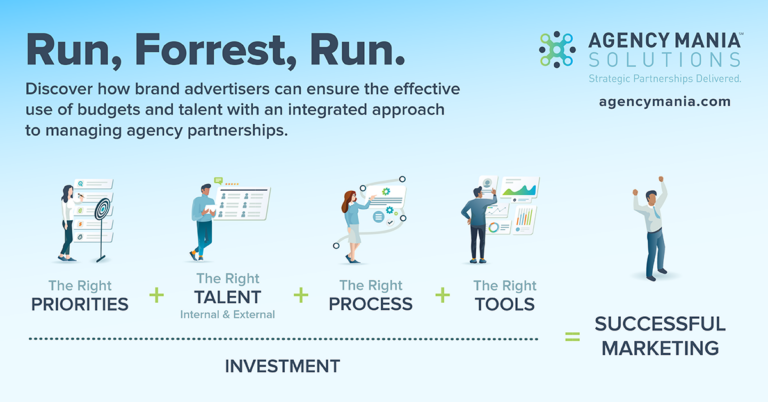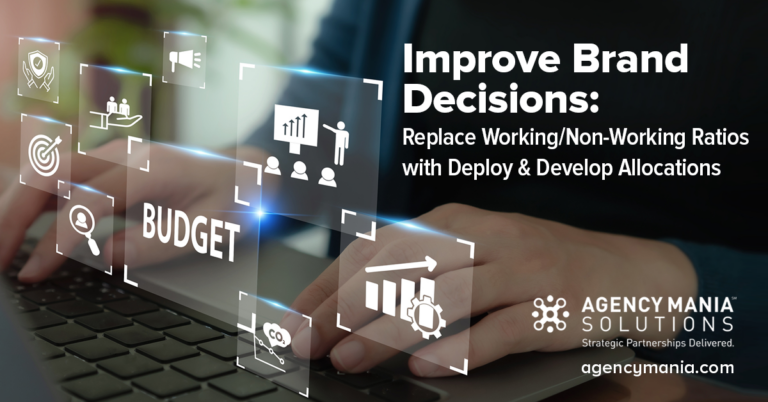Partnership for Success…. and Survival.
In this increasingly complex, interconnected, demanding world we live in, if there is one certainty, it is the following: no one can or will succeed alone. In 2010, for the 100th anniversary of the Association of National Advertisers (ANA), I was invited to write an article for their magazine that I titled “Relationship Capital.” There was no better, more symbolic time than this historic milestone to emphasize that. Following years of economic progress driven by human knowledge and intellectual capital, the next phase of progress was going to be in well-managed “partnerships” or “relationship capital.” Ten years later, that vision is now a reality. Let’s review together what it will take to partner for success in years to come.
What PARTNERING should stand for
One of the common, yet complex questions marketers ask themselves is: What are the key ingredients to building partnerships that keep on performing? Whether an advertiser is working with external partners or its own in-house agency teams, its organizational success is always highly dependent on the quality and effectiveness of that collaboration. Here are 10 essential ingredients to PARTNERING for success :
1. PROFICIENCY – “a high degree of competence or skill; expertise.”
Any partnership is based on a set of competencies that are desired and valued by the other partner. The advertiser looks for subjectmatter expertise in a specific area of competency that the agency offers. The agency understands that maintaining and strengthening that subject matter expertise is a necessity to deliver sustained value to clients. Similarly, clients offer deep product or market knowledge that the agency depends on to formulate its ideas. The need to secure subject matter expertise is what motivated Marriott International to recently appoint Alma as its social media AOR for the Caribbean and Latin American region. Or luxury car maker Maserati to hire Droga5, both Ad Age and Adweek’s Agency of the Decade, as its global creative AOR in addition to its existing digital duties. Proficiency is the gateway to shared value creation.
2. ACCOUNTABILITY – “the fact or condition of being accountable; responsibility.”
Mutual accountability is a core expectation in any durable partnership. The agency must be accountable to deliver against clients’ expectations and its various work commitments. Conversely, the advertiser must also set up the agency for success by providing it what it needs to perform: budget, guidance and priorities, resources, etc. They are profoundly accountable to each other. Last year’s most awarded campaigns – Essity’s Viva La Vulva, the NY Times’ “The Truth Is Worth It,” and Skittles’ “The Broadway Musical”— are” sound examples of this. The push for joint responsibility is without a doubt what also led Burger King to demand more from its partners, pushing the creative envelope with INGO, David, and Publicis, winning their 56th International Andy Award for the “Moldy Whopper” campaign.
3. RESILIENCE – “the capacity to recover quickly from difficulties; toughness.”
Healthy, yet demanding relationships are always under some pressure. The tension is therefore inevitable during the engagement. As issues arise and obstacles naturally emerge, the ability to overcome them and recover quickly is an essential quality for partners to exhibit. They must solicit and provide feedback. They must look for ways to strengthen the work and the relationship. They must be committed to the partnership and show tremendous resilience to ultimately succeed. This is exactly what drives countless leaders to defend their account as the incumbent agency when a client puts it up for review. They may also need to reevaluate what they do, how they do it, and prepare for change. As the industry prepares for a world without third party cookies, resilience is what clearly led Horizon Media to building out the agency’s own in-house data hub for people based and targeted capabilities with TransUnion, instead of relying on third party data aggregators.
4. TRANSPARENCY – “the condition of being transparent – easy to perceive or detect.”
Transparency is the basis for trust. And trust is the fuel that propels any relationship. Without complete transparency, agencies must guess what their clients want or value most. Without it, the work suffers. For example, the client’s attention may be diverted to reporting, examining, and auditing, instead of focusing on the work at hand. This is a key driver behind Procter & Gamble and Unilever joining forces with Google, Facebook, and other key players to lead a cross-media measurement initiative formed by the World Federation of Advertisers that improves transparency and accountability. One may conclude that this is a key factor in Accenture’s decision to shut down its media auditing arm to address rising questions about conflict of interest between its various offerings. Transparency has become the currency of modern partnerships and an important part of how we must do business.
5. NIMBLENESS – “quick and light in movement or action; agile.”
The most effective partnerships are highly flexible and adaptable. They can quickly adjust to changing conditions. They move in synch with each other. They must rely on structured operating principles and terms. Yet too much rigor can often get in the way of creativity or speed to market. The more agile they are together, the quicker they can successfully deliver despite changing market conditions or rapidly shifting client direction. As the brand Asics prepared to launch its Olympics shoe, this type of nimbleness enabled the shoe company to work in 24hour shifts with PR firm Edelman and Solarflare Studio in order to quickly adjust their launch plans amid the COVID-19 situation. It’s also what led chocolate brand Russell Stover to quickly shift priorities with agency Cutwater and create a virtual “Great Bunny Hunt” for Easter with key influencers who hid the bunnies in their posts. Adaptability and nimbleness are a must.
6. EFFICIENCY – “achieving maximum productivity with minimum effort or expense.”
Resources are in limited supply. Talent, time, and energy become major sources of investment, investments that must pay off in terms of return. The output — commonly expressed in terms of deliverables or business performance — must be measured objectively and continuously. Client/ agency partnerships cannot thrive long-term unless efficiency metrics in media, production, or agency fees are part of the portfolio of KPIs they use to produce great and affordable work. This is what motivates brand advertisers to eliminate waste and ask their agencies — in collaboration with specialty firms like eg+ — to take on COVID-19 production challenges like reducing production budgets, re-using content, or using lowcost production hubs and locations. This is what also motivates brands to consider handling some work in-house like Procter & Gamble (P&G), which has been reported to now handle 30% of its $7 billion global media spend in-house.
7. RESOURCEFULNESS – “the ability to find clever ways to overcome difficulties.”
Agencies are asked to handle client budgets responsibly, looking for opportunities to simplify, cut fat, and identify efficiencies and creative ways to complete their work, minimizing time, effort, and resources in doing so. How can they consistently be expected to do more with less? How can they find new, ingenious ways to overcome unexpected challenges? Their resourcefulness is tested regularly, as it also is for clients searching for clever solutions to getting things done internally. It is that resourcefulness that led PR firm Mister Sweat to launch a consulting practice called “Sweat + Co” aimed at helping agencies survive the COVID-19 crisis. Perhaps this is what also motivated jewelry retailer Jared and its agency Publicis to offer 1,000 free wedding ceremonies to couples, under the campaign #LoveCantWait, via their online hosting platform. Resourcefulness breeds innovation. Innovation breeds winning teams.
8. INCENTIVE – “a thing that motivates or encourages one to do something.”
Having the right incentive or metrics for success in place is a critical element of any partnership. Getting alignment on Key Performance Indicators (KPIs) will ensure the effective use of talent and resources. Clients play an important role in setting up these expectations based on what matters in terms of tangible business and marketing results. And agencies must show their commitment to meeting or exceeding key client metrics. Some agencies even go the extra mile to show their commitment to tangible results. This is what led Publicis Groupe to launch a new offering called “The Pact,” which offers small-to-mediumsized businesses a 100% refund should the agency fail to deliver on agreed-upon KPIs using its Epsilon capabilities. Another great example is Meredith Corporation launching the Meredith Audience Action Guarantee, a program guaranteeing that a specified number of readers will act in response to seeing campaigns in Meredith magazines.
9. NURTURING – “caring for and encouraging growth or development.”
Partnerships are not built overnight. It takes effort and commitment, but it also takes time to fine-tune and nurture a relationship. Agencies are skilled at building and nurturing client relationships. Clients play a vital role as well, showing care, being protective, and acknowledging their top partners. It was nurturing that led Procter & Gamble Co. to nominate six of its ad agencies for Agency Excellence Awards for their exceptional work. Agencies also find ways to nurture their relationships with clients by organizing themselves tightly around them, such as MDC Partners launching a new Anomaly-led alliance (it calls “lumbering”) to house many of its capabilities under one network. This is what led WPP to launch WPP Black Ops, a bespoke startup that hand-picks staff from within WPP-owned agencies. Nurturing is essential to growing relationships and strengthening them.
10. GROWING – “becoming greater over a period of time; increasing.”
Strong partnerships will grow and expand over time. Most business relationships start small. The agency must prove itself to be rewarded with more business. The client must also prove itself to be a worthy, reasonable partner. It’s quite common for advertisers to seek greater economies of scale and consolidate the work with fewer partners when these agency partners show continued performance. This is what happened when Bank of America consolidated its advertising business with a dedicated Publicis Groupe team called GroupeConnect. Other recent examples include toymaker giant Hasbro, which consolidated its global media business with WPP-owned GroupM’s MediaCom, or GSK, which consolidated its Pfizer consumer healthcare media business under Publicis Media. Partnerships are meant to grow, as is their tangible value.
How to achieve Partnership Excellence
The concept of “successful partnership” is nothing short of being tautological. Organizational success can only be achieved through effective partnerships. In recent years, brand advertisers have thankfully built these partnership muscles and established more thoughtful and rigorous processes on how to work better with their roster agencies. In years to come, the best marketers will also be the best partners.







